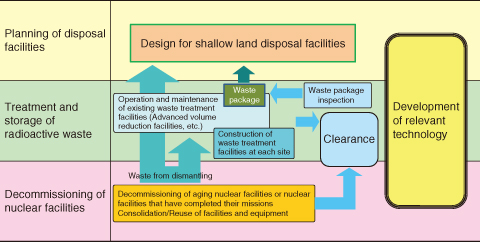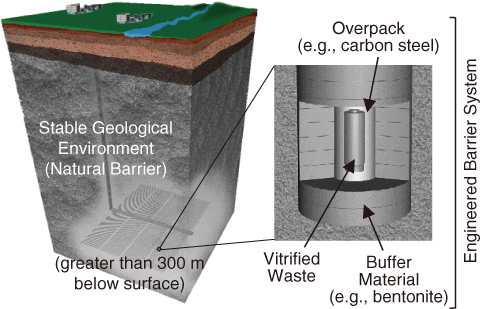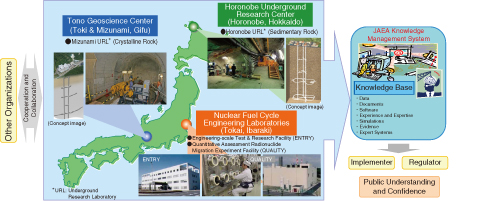
Fig.8-1 Outline of measures for decommissioning of nuclear facilities and treatment and disposal of radioactive waste
We are setting up systems to decommission nuclear facilities and manage radioactive waste. In addition, we are developing related technologies (e.g., decommissioning, treatment, and disposal) and constructing radioactive waste treatment and disposal facilities.

Fig.8-2 Schematic view of basic concept for the geological disposal of high-level radioactive waste (HLW) in Japan

Fig.8-3 System for implementing JAEA R&D activities
Safe and efficient decommissioning of our nuclear facilities and treatment and disposal of radioactive wastes are important issues to consider in our research and development activities. We are currently setting up systems to decommission nuclear facilities and manage radioactive waste and are also developing the related technologies (Fig.8-1).
Furthermore, we will be responsible for disposing radioactive waste generated not only from our research facilities but also from universities, industrial facilities, and other sites.
R&D for the decommissioning of nuclear facilities
We have developed an engineering system for decommissioning and a verification or evaluation system for clearance. It is important to assess the applicability of these systems to the decommissioning of several nuclear facilities of JAEA. We already confirmed that the system is applicable to a research reactor. This time, we applied the system to decommissioning of the Uranium Refining and Conversion Plant, which is one of the nuclear fuel cycle facilities, and showed that the system is applicable to it. (Topic 8-1).
R&D for waste treatment and disposal
There are various chemical forms of sludge-like uranium-bearing waste, and its uranium concentration is very high.
We must select which uranium separation process to apply to various uranium-bearing wastes. Therefore, we have been developing a process for selective separation of uranium by using mineral acid. As part of this study, we confirmed that the process that uses hydrochloric acid is applicable to the CaF2 sludge and spent filter aid (Topic 8-2).
R&D to characterize radioactive waste
For the safe disposal of radioactive waste packages, their radioactive content must be evaluated. Therefore, we developed related techniques to enable reasonable and effective analysis of the radioactive waste. However, because some radionuclides contained in the radioactive waste are hard to analyze, we developed a new method to analyze 242mAm (Topic 8-3).
Moreover, to deal with the accident at the Tokyo Electric Power Company, Incorporated (TEPCO) Fukushima Daiichi Nuclear Power Station (NPS), we are developing a new analytical method to measure the concentration of radionuclides in the wastewater. Our systematic method to analyze radioactive waste is also being applied to determine the concentration of radionuclides in or on the rubble and trees (Chapter 1, Topics 1-20, 1-21).
Disposal of low-level radioactive waste
Trench-type disposal is a method for disposing low-level radioactive waste in a facility without engineered barrier located at a few meters below the surface. To improve the safety of the trench facility, it is important to reduce the rate at which rainfall infiltrates into the waste layer (due to the low permeability of cover soil). Therefore, we evaluated the rate of water infiltration when a geomembrane and a low-permeability soil layer are installed in the upper cover soil, considering the permeability of these layers. We found out that using a low-permeability soil layer and a geomembrane is effective to reduce water infiltration rate into the waste layer of the trench facility (Topic 8-4).
R&D to Improve Technology and Reliability of Geological Disposal in Japan
Geological disposal is one option for long-term isolation from human environments of high-level radioactive waste (HLW) produced during nuclear power generation. This is a critical issue that the present generation must sensibly deal and that remains crucial despite any revision of the national nuclear energy policy. In Japan, spent fuel from power reactors is reprocessed to extract reusable uranium and plutonium for power generation. The liquids separated from the spent fuel during chemical reprocessing are solidified into a stable glass form. In the Japanese disposal concept, vitrified wastes are encapsulated in a thick steel overpack surrounded by highly compacted bentonite and then placed in a stable geological environment at more than 300 m below the surface (Fig.8-2). Implementing geological disposal of HLW is a long-term project that will last over 100 years. The project begins with site selection and continues to repository construction and operation, which will be followed by backfill for repository closure. It is thus of great importance to proceed efficiently with the project, as a national responsibility, by continuously improving its sound technical basis and applying these attitudes to implementation, regulatory activities, and, most importantly, to enhance public confidence. To this end, we made and will continue to make steady progress in research and development (R&D) in various fields, such as in geoscience, repository engineering, and safety assessment, to improve the technologies used for and reliable geological disposal in Japan.
At present, our R&D focuses specifically on projects at two underground research laboratories (URLs)-one at Mizunami, which researches crystalline rocks, and the other at Horonobe, which researches sedimentary formations (Fig.8-3)-with the main aim being to develop a sound technical basis for formulating and implementing safety regulations. At the end of 2013, some research galleries were made available for use at a depth of 500 m at Mizunami and at 350 m at Horonobe. Multidisciplinary investigations are ongoing, because the reliability of various investigative techniques should be tested and verified before the site characterization program begins (Topics 8-5, 8-6, and 8-7). In addition, studies on tectonics, volcanic and faulting activities, and so on are in progress to evaluate the long-term stability of geological environments in Japan (Topics 8-8 and 8-9). In parallel with such geoscience efforts, we are conducting an extensive study to assess the performance of the disposal system, of engineered barrier systems, and of the long-term chemistry and migration of radionuclides at Tokai to expand our knowledge base for geological disposal (Topics 8-10, 8-11, and 8-12). These studies exploit data and information about geological environments that were obtained through geoscience research at both URLs. The prototype knowledge management system that was developed in 2010 is being improved to systematically provide and transfer multiple associated R&D results to both implementer and regulator and to ensure their safety.
Our efforts also focus on promoting public understanding by disseminating relevant information and by opening our R&D facilities to the public.
Implementing Safety Measures at Tokai Reprocessing Plant and Enhancing Reprocessing Technologies
After the Great East Japan Earthquake and the accident at the TEPCO’s Fukushima Daiichi NPS, various emergency safety measures were implemented at the Tokai Reprocessing Plant (TRP). To reduce the probability of hazards at the TRP, efforts focused on solidifying and stabilizing as soon as possible the highly active liquid waste (HALW) at the Tokai Vitrification Facility (TVF) and the plutonium solution at the Plutonium Conversion Development Facility (PCDF). Vitrifying the all stored HALW is estimated to require two decades. Thus, an advanced glass melter is under development to make steady progress on the solidification and stabilization of the HALW.
For low-level radioactive effluents, a cement-based solidification method accompanying a nitrate-ion decomposition process has been developed to reduce the environmental impact.
The following studies on advanced reprocessing technologies are ongoing:
- Separating Ruthenium from HALW (Topic 8-13).
- Developing Uranium and Plutonium co-recovery process.